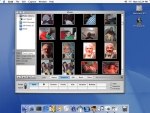We pause now for a brief technical moment.
Most modern digital cameras attach metadata to the JPEG files that they create and transfer to a host PC. The metadata contains information like the date and time the picture was taken, the model and make of the camera, whether a flash was used and so on. This metadata is structured according to a format known as EXIF or Exchangeable Image File, and its specification is available online.
Normally we humble users don’t have to worry about this EXIF information because most smart photo cataloging and editing programs understand and preserve this section of the JPEG file, and use it wisely. One such an example of a program is Apple’s new iPhoto (pictured right).

Today I imported about 3,000 digital photos into iPhoto, and was surprised to see about 45 of them sorted “out of order” when I sorted them all by date. It appears as though the date on my digital camera was off by a year when I took those photos — it was reading 2000 as the year during 2001.
I deleted the photos from iPhoto, changed their file creation time (thinking this is where iPhoto was getting the date information from), and re-imported them. No change in iPhoto. It’s only at this point that I became aquainted with the mystical world of EXIF data.
Suffice to say that what I needed was a EXIF editor so I could change the [wrong by a year] date information embedded in the JPEG files themselves. I couldn’t actually find a EXIF editor, but what I did find, a program called Exifer (for Windows only) let me extract the EXIF data, do a search and replace with a simple text editor, and then re-attach the modified EXIF data to the photos. So I was able to move the photos from 2000 into 2001, import them into iPhoto, and have them appear in the proper year.
Lots of learning to solve a simple problem!
Initial impressions of Apple’s iPhoto: it’s slower on my iBook by a factor of 2 than it was when Steve Jobs demonstrated it at MacWorld today (probably because he was using some super-powerful desktop with a fast hard drive); I’m frustrated that I can’t create nested categories (aka Albums), but this seems to be the Apple Way, as it reflects a similar limitation (or feature?) in their iTunes product. Otherwise it’s pretty nifty, and much, much better a photo cataloger than I’ve ever used on a PC.
 I am
I am
Comments
Hi Peter…. Long time no see
Hi Peter…. Long time no see…
When I run across that sort of stuff I pull out something called “UltraEdit”. It’s basically a hex editor but it also has the ability to work on a whole barnyard full of files at the same time.
Trial version is here… http://www.ultraedit.com/
One great file for the long term tool box
Hi there! It seems I was so
Hi there! It seems I was so excited to get my digital camera that I actually set it to the wrong year and now 3000 pictures later they’re all wrong. So I need to do what you’ve done using EXIFER but on a grand scale. I downloaded the program per your recommendation and I can’t find where to attach the information back onto the files. Perhaps you could walk me through what you did? I’d appreciate it very much — hard to believe I let this slip for so long! ~Chris
Chis,You can fix wrong year
Chis,
You can fix wrong year with AttributeMagic Pro utility.
http://www.AttributeMagic.com
You’ll find a lot of options using AttributeMagic.
Roman.
I just tried Photo SudioFree
I just tried Photo Sudio
Free and easier to use than EXIFIER:
http://www.stuffware.co.uk/pho…
Add new comment